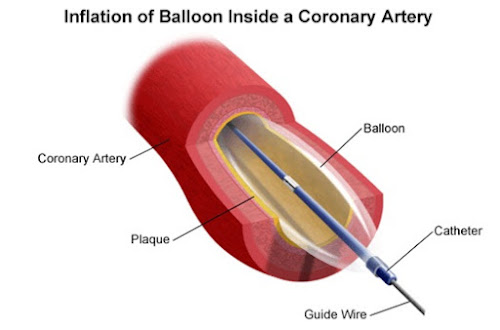SUCCESS OF ANGIOPLASTY - THE HIDDEN FACTS
The medical world claims that the success rate for PTCA exceeds 95% for dilating a target lesion (blockage) so that its residual stenosis is <50% (<30% when a stent has been used). Is it actually a success? After paying your hard earned money, you actually get a reblockage of 30%-50% immediately after the angioplasty! And the time required to reach back to more than 70% is easy to guess. No wonder you get so many cases of reblockage occurring within no time. In approximately 20% of patients, evidence of recurrent ischaemia (reblockage i.e. Blockage more than 70%), develops within 6 months, due to restenosis of dilated segment. But the hospitals try to convert this failure of PTCA into a success story by hiding the actual facts from the patients. How can this procedure be successful when 20 people out of 100 get reblocks just within six months? The actual figure will be very high, these are the figures which the official statistics claim!
About half of the failures of PTCA result from in ability to cross the target lesion, with the guide wire, particularly when the target lesion is a chronic total occlusion. This means that in 50% or more of the cases the procedure will fail! Then why are the hospitals making the procedure so common and put the patient through so much of risk and mental/financial agony?
Injury to the tube during the procedure can lead to formation of clot locally and the irritation can cause spasm of the artery. This occurs in approximately 3% of angioplasty attempts that can necessitate an emergency bypass! This means that three patients out of hundred will end up with an emergency bypass surgery.
In upto 1% of patients undergoing PTCA especially atherectomy, perforation of the coronary artery can occurs leading to bleeding (leakage of blood outside the heart muscle) which is very dangerous.
Finally, angioplasty can cause all the other complications that an angiographic procedure can cause!
Before 1977 Bypass Surgery was the only form of revascularization available to treat coronary artery disease. In that year, Andreas Gruntziz performed the first catheter based coronary revascularization, which he named PTCA (Precutaneous Transluminal Coronary Angioplasty). With crude early equipment and limited anatomic capability, fewer than 1000 such procedures were performed worldwide annually until 1981. In United States only, it grew to more than 3,00,000 till the early 90s. Number of newer devices came like stents and atherectomy devices. The current annual number in United States only is 6,00,000.
Hope you liked this blog!
This article is written by Dr. Bimal Chhajer ( Heart Specialist)



Comments
Post a Comment